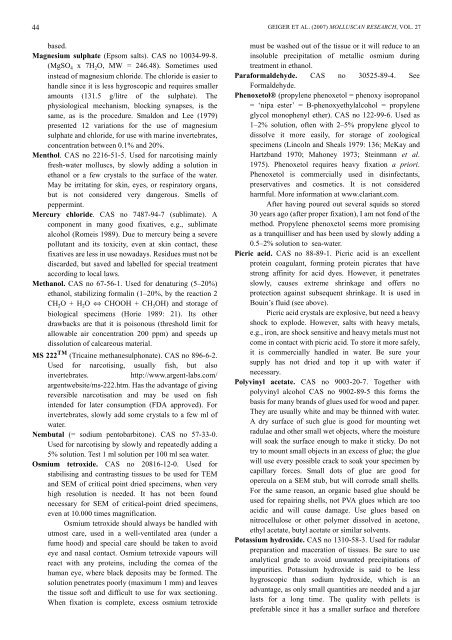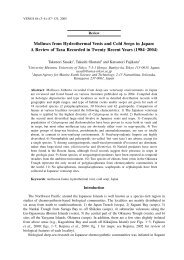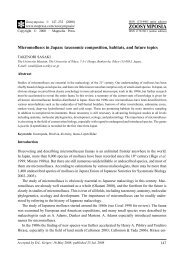Molluscan Research: Techniques for collecting, handling, preparing ...
Molluscan Research: Techniques for collecting, handling, preparing ...
Molluscan Research: Techniques for collecting, handling, preparing ...
You also want an ePaper? Increase the reach of your titles
YUMPU automatically turns print PDFs into web optimized ePapers that Google loves.
44<br />
based.<br />
Magnesium sulphate (Epsom salts). CAS no 10034-99-8.<br />
(MgSO 4 x 7H 2 O, MW = 246.48). Sometimes used<br />
instead of magnesium chloride. The chloride is easier to<br />
handle since it is less hygroscopic and requires smaller<br />
amounts (131.5 g/litre of the sulphate). The<br />
physiological mechanism, blocking synapses, is the<br />
same, as is the procedure. Smaldon and Lee (1979)<br />
presented 12 variations <strong>for</strong> the use of magnesium<br />
sulphate and chloride, <strong>for</strong> use with marine invertebrates,<br />
concentration between 0.1% and 20%.<br />
Menthol. CAS no 2216-51-5. Used <strong>for</strong> narcotising mainly<br />
fresh-water molluscs, by slowly adding a solution in<br />
ethanol or a few crystals to the surface of the water.<br />
May be irritating <strong>for</strong> skin, eyes, or respiratory organs,<br />
but is not considered very dangerous. Smells of<br />
peppermint.<br />
Mercury chloride. CAS no 7487-94-7 (sublimate). A<br />
component in many good fixatives, e.g., sublimate<br />
alcohol (Romeis 1989). Due to mercury being a severe<br />
pollutant and its toxicity, even at skin contact, these<br />
fixatives are less in use nowadays. Residues must not be<br />
discarded, but saved and labelled <strong>for</strong> special treatment<br />
according to local laws.<br />
Methanol. CAS no 67-56-1. Used <strong>for</strong> denaturing (5–20%)<br />
ethanol, stabilizing <strong>for</strong>malin (1–20%, by the reaction 2<br />
CH 2 O + H 2 O ⇔ CHOOH + CH 3 OH) and storage of<br />
biological specimens (Horie 1989: 21). Its other<br />
drawbacks are that it is poisonous (threshold limit <strong>for</strong><br />
allowable air concentration 200 ppm) and speeds up<br />
dissolution of calcareous material.<br />
MS 222 TM (Tricaine methanesulphonate). CAS no 896-6-2.<br />
Used <strong>for</strong> narcotising, usually fish, but also<br />
invertebrates.<br />
http://www.argent-labs.com/<br />
argentwebsite/ms-222.htm. Has the advantage of giving<br />
reversible narcotisation and may be used on fish<br />
intended <strong>for</strong> later consumption (FDA approved). For<br />
invertebrates, slowly add some crystals to a few ml of<br />
water.<br />
Nembutal (= sodium pentobarbitone). CAS no 57-33-0.<br />
Used <strong>for</strong> narcotising by slowly and repeatedly adding a<br />
5% solution. Test 1 ml solution per 100 ml sea water.<br />
Osmium tetroxide. CAS no 20816-12-0. Used <strong>for</strong><br />
stabilising and contrasting tissues to be used <strong>for</strong> TEM<br />
and SEM of critical point dried specimens, when very<br />
high resolution is needed. It has not been found<br />
necessary <strong>for</strong> SEM of critical-point dried specimens,<br />
even at 10.000 times magnification.<br />
Osmium tetroxide should always be handled with<br />
utmost care, used in a well-ventilated area (under a<br />
fume hood) and special care should be taken to avoid<br />
eye and nasal contact. Osmium tetroxide vapours will<br />
react with any proteins, including the cornea of the<br />
human eye, where black deposits may be <strong>for</strong>med. The<br />
solution penetrates poorly (maximum 1 mm) and leaves<br />
the tissue soft and difficult to use <strong>for</strong> wax sectioning.<br />
When fixation is complete, excess osmium tetroxide<br />
GEIGER ET AL. (2007) MOLLUSCAN RESEARCH, VOL. 27<br />
must be washed out of the tissue or it will reduce to an<br />
insoluble precipitation of metallic osmium during<br />
treatment in ethanol.<br />
Para<strong>for</strong>maldehyde. CAS no 30525-89-4. See<br />
Formaldehyde.<br />
Phenoxetol® (propylene phenoxetol = phenoxy isopropanol<br />
= ‘nipa ester’ = B-phenoxyethylalcohol = propylene<br />
glycol monophenyl ether). CAS no 122-99-6. Used as<br />
1–2% solution, often with 2–5% propylene glycol to<br />
dissolve it more easily, <strong>for</strong> storage of zoological<br />
specimens (Lincoln and Sheals 1979: 136; McKay and<br />
Hartzband 1970; Mahoney 1973; Steinmann et al.<br />
1975). Phenoxetol requires heavy fixation a priori.<br />
Phenoxetol is commercially used in disinfectants,<br />
preservatives and cosmetics. It is not considered<br />
harmful. More in<strong>for</strong>mation at www.clariant.com.<br />
After having poured out several squids so stored<br />
30 years ago (after proper fixation), I am not fond of the<br />
method. Propylene phenoxetol seems more promising<br />
as a tranquilliser and has been used by slowly adding a<br />
0.5–2% solution to sea-water.<br />
Picric acid. CAS no 88-89-1. Picric acid is an excellent<br />
protein coagulant, <strong>for</strong>ming protein picrates that have<br />
strong affinity <strong>for</strong> acid dyes. However, it penetrates<br />
slowly, causes extreme shrinkage and offers no<br />
protection against subsequent shrinkage. It is used in<br />
Bouin’s fluid (see above).<br />
Picric acid crystals are explosive, but need a heavy<br />
shock to explode. However, salts with heavy metals,<br />
e.g., iron, are shock sensitive and heavy metals must not<br />
come in contact with picric acid. To store it more safely,<br />
it is commercially handled in water. Be sure your<br />
supply has not dried and top it up with water if<br />
necessary.<br />
Polyvinyl acetate. CAS no 9003-20-7. Together with<br />
polyvinyl alcohol CAS no 9002-89-5 this <strong>for</strong>ms the<br />
basis <strong>for</strong> many brands of glues used <strong>for</strong> wood and paper.<br />
They are usually white and may be thinned with water.<br />
A dry surface of such glue is good <strong>for</strong> mounting wet<br />
radulae and other small wet objects, where the moisture<br />
will soak the surface enough to make it sticky. Do not<br />
try to mount small objects in an excess of glue; the glue<br />
will use every possible crack to soak your specimen by<br />
capillary <strong>for</strong>ces. Small dots of glue are good <strong>for</strong><br />
opercula on a SEM stub, but will corrode small shells.<br />
For the same reason, an organic based glue should be<br />
used <strong>for</strong> repairing shells, not PVA glues which are too<br />
acidic and will cause damage. Use glues based on<br />
nitrocellulose or other polymer dissolved in acetone,<br />
ethyl acetate, butyl acetate or similar solvents.<br />
Potassium hydroxide. CAS no 1310-58-3. Used <strong>for</strong> radular<br />
preparation and maceration of tissues. Be sure to use<br />
analytical grade to avoid unwanted precipitations of<br />
impurities. Potassium hydroxide is said to be less<br />
hygroscopic than sodium hydroxide, which is an<br />
advantage, as only small quantities are needed and a jar<br />
lasts <strong>for</strong> a long time. The quality with pellets is<br />
preferable since it has a smaller surface and there<strong>for</strong>e




